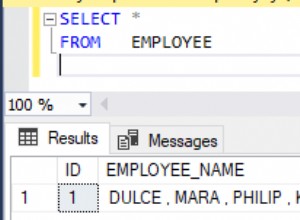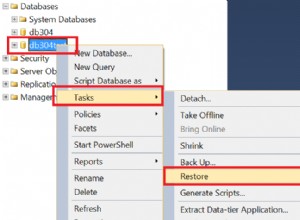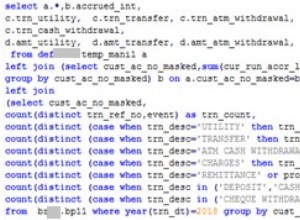Non dovresti dividere la query in due query. Dovresti selezionare/impostare il risultato all'interno della query di inserimento.
Ho fatto un esempio per te:
Il primo metodo sta restituendo un singolo valore con l'uso di select
private void Method1()
{
string sEmail = "[email protected]";
string passwordHash = "#[email protected]#[email protected]!#@[email protected]#!#@$!#@$!";
string salt = "????";
string sName = "John";
using (SqlConnection sqlConnection = new SqlConnection(_connectionString))
try
{
sqlConnection.Open();
string insertStatement = "INSERT INTO [User] "
+ "(email, hash, salt, name) "
+ "VALUES (@email, @hash, @salt, @name)"
+ "SELECT SCOPE_IDENTITY()";
using (SqlCommand insertCommand = new SqlCommand(insertStatement, sqlConnection))
{
insertCommand.Parameters.Add("@email", SqlDbType.VarChar, 50).Value = sEmail;
insertCommand.Parameters.Add("@hash", SqlDbType.VarChar, 50).Value = passwordHash;
insertCommand.Parameters.Add("@salt", SqlDbType.VarChar, 50).Value = salt;
insertCommand.Parameters.Add("@name", SqlDbType.VarChar, 50).Value = sName;
int userId = Convert.ToInt32(insertCommand.ExecuteScalar());
Trace.WriteLine("User created with id: " + userId);
}
}
catch (SqlException ex)
{
Trace.WriteLine(ex.Message);
//lblMessage.Text = ex.Message;
}
}
Il secondo metodo è definire un parametro di output, in questo modo puoi restituire più valori.
private void Method2()
{
string sEmail = "[email protected]";
string passwordHash = "#[email protected]#[email protected]!#@[email protected]#!#@$!#@$!";
string salt = "????";
string sName = "John";
using (SqlConnection sqlConnection = new SqlConnection(_connectionString))
try
{
sqlConnection.Open();
string insertStatement = "INSERT INTO [User] "
+ "(email, hash, salt, name) "
+ "VALUES (@email, @hash, @salt, @name)"
+ "SET @user_id = SCOPE_IDENTITY()";
using (SqlCommand insertCommand = new SqlCommand(insertStatement, sqlConnection))
{
insertCommand.Parameters.Add("@email", SqlDbType.VarChar, 50).Value = sEmail;
insertCommand.Parameters.Add("@hash", SqlDbType.VarChar, 50).Value = passwordHash;
insertCommand.Parameters.Add("@salt", SqlDbType.VarChar, 50).Value = salt;
insertCommand.Parameters.Add("@name", SqlDbType.VarChar, 50).Value = sName;
insertCommand.Parameters.Add("@user_id", SqlDbType.Int).Direction = ParameterDirection.Output;
insertCommand.ExecuteNonQuery();
int userId = Convert.ToInt32(insertCommand.Parameters["@user_id"].Value);
Trace.WriteLine("User created with id: " + userId);
}
}
catch (SqlException ex)
{
Trace.WriteLine(ex.Message);
//lblMessage.Text = ex.Message;
}
}
Il meglio che puoi fare è, se le query sono statiche, inserire queste query all'interno delle procedure memorizzate. Ciò accelererà le query.




